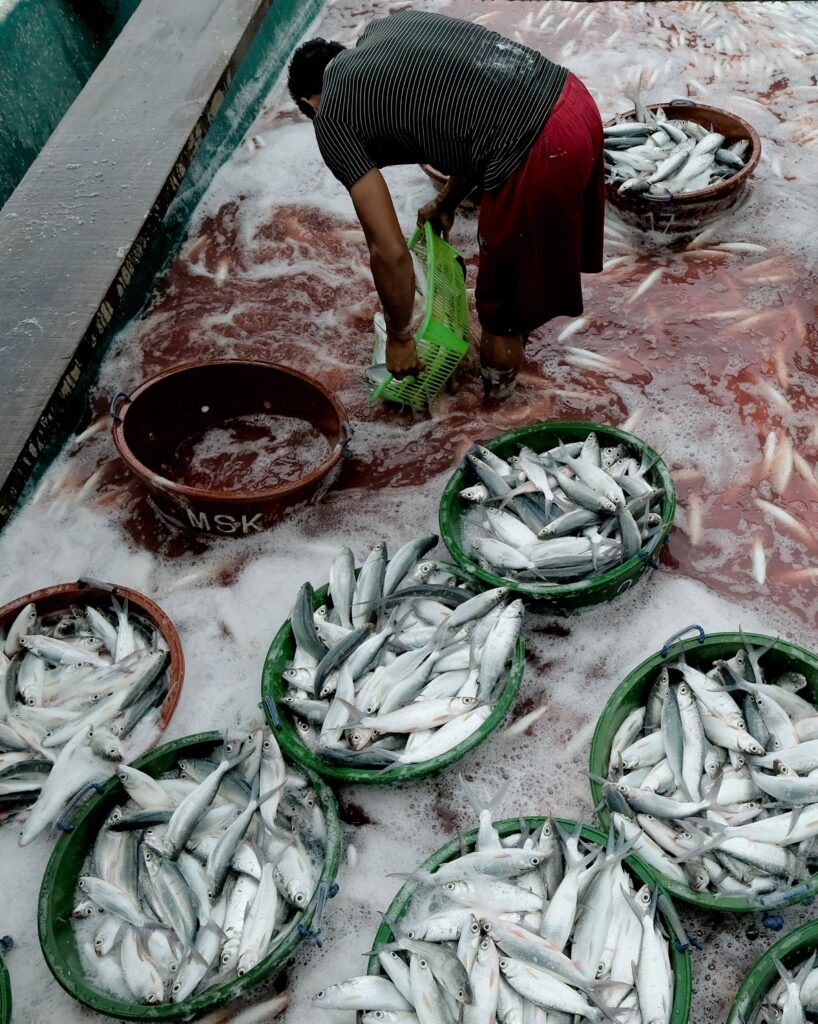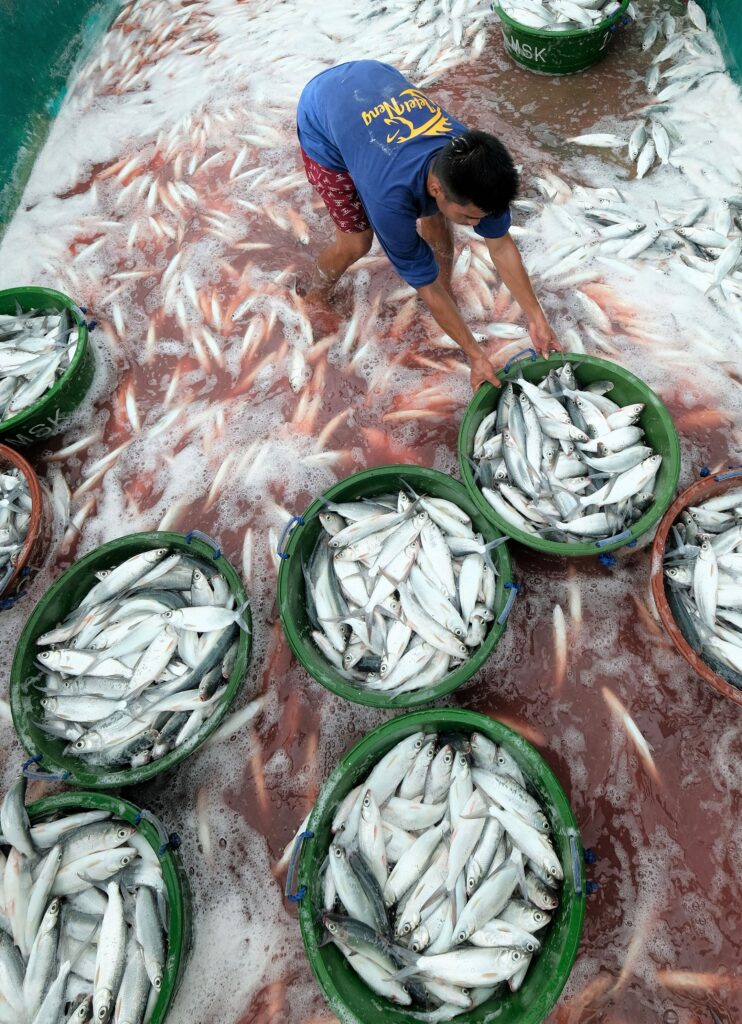Text by Henrylito D. Tacio
Photos by Rhoy T. Cobilla
While fish is not an important source of calories in the human diet, it does have an important role in the food supply of many communities, especially in developing countries like the Philippines.
“Fish protein is generally recognized as a valuable ingredient in a balanced diet,” said Dr. Veravat Hongskul, former regional fishery officer of the UN Food and Agriculture Organization. “It is of high biological value and contains essential amino acids not normally found in staple food.
“The oil from the fish,” he continued, “also contains essential fatty acids, which are necessary for the proper development of the brain and the body. Where staple foods are available, a small quantity of fish can contribute significantly to increasing consumption by improving the overall palatability of the food and add to its nutritive value.”
During his time, Jules Verne suggested that when the world reached the limits of food production on land, man could turn to the oceans. Unfortunately, many countries have been doing just that over the past several decades.
“Between 1950 and 1989, the fish catch expanded more than four-fold, climbing from 22 million tons to 100 million tons,” Lester R. Brown reported in his feature, “Facing Food Scarcity.” “During the six years since then, the catch has leveled off. Contrary to the prognosis of Jules Verne, we reached the limits of the oceans first.”
In the Philippines, fish provides more than half of the protein requirement of almost all people. But in recent years, the average annual consumption has declined from 37 kilos to just 30 kilos. “Unless we look for other sources of protein, the food intake of Filipinos will be greatly affected,” said an official of Bureau of Fisheries and Aquatic Resources (BFAR).


The Philippines is among the largest fish producers in the world, the World Bank report states. The commercial, municipal, and aquaculture fisheries account for 36, 30, and 24 percent of the total fisheries yield, respectively. Its annual total fisheries yield is estimated to be worth around US$70 to UD$110 billion (equivalent to about 2-4 percent of the country’s gross domestic production over the years).
Dwindling fish supply
Unless something is done soon, fish production may soon collapse. Dr. Salome Bulayog, an associate professor of the department of economics at the Visayas State University, said the aquatic marine resources of Sogod Bay in Southern Leyte have been deteriorating in recent years.
Home to a variety of fishes, Sogod Bay is a major fishing ground for the 11 municipalities that surround it. Mangko or frigate tuna (scientific name: Euthynnus affinis) is its major fishery resource. Seasonal influx of this shallow-water tuna species has provided food and livelihood to the people of Sogod and nearby municipalities.
“Frigate tuna used to abound in Sogod Bay and was a major source of income in the 70’s until the 90’s,” said Dr. Bulayog, who headed the study. “But today, fishermen could hardly catch fish.”
“Likewise, reef species population is also dwindling,” added the study, which was conducted in 1994 yet. “Fishermen have to spend longer to catch a kilogram of fish; some even have to be farther from the shore.”
And so it came to pass that the wealth of oceans, once considered boundless, has proven finite. Touted as “the poor man’s protein,” fish is now a resource coveted — and fought over by countries.
“We are running out of fish and running out of time. For a country known for marine biodiversity, there are very few fish left to catch,” Vince Cinches, Oceans Campaigner for Greenpeace Southeast Asia, was quoted as saying.
“Like the other vital resources such as forests, Philippine fisheries are about to collapse,” deplored Jethro P. Adang, the director of Mindanao Baptist Rural Life Center (MBRLC), a non-government organization based in Davao del Sur.
Fish farming
Fish are the “last wild meal” in the human diet. If the oceans are running low on many of humanity’s favorite fish, the solution would seem obvious: raise more seafood down on the fish farm, expanding the maritime version of agriculture known as aquaculture. After all, aquaculture has been a source of human protein for nearly 4,000 years, especially in Asia.
In recent years, aquaculture has become big business. Supermarkets in affluent countries are awash in scallops farmer-raised in China, mussels nurtured in New Brunswick and pen-reared cod from Newfoundland. One-quarter of the world’s shrimps are raised in ponds in 50 countries, with Thailand and Ecuador leading the harvest.
Fish farming is more advantageous than raising livestock. “For every kilogram of dry feed, we get one kilogram of fish meat,” said Dr. Uwe Lohmeyer of the Deutsche Gesselschaft fur Technische Zusammernarbeit (GTZ), a German Technical Cooperation. “This is a far more favorable rate than in the case of say, pigs: to produce the same quantity of pork, a farmer – given the same quality of inputs – has to provide three kilograms of feed.”
Though a novelty in much of the world, aquaculture has been practiced through the ages. Oyster culture, for instance, thrived in ancient Rome and Gaul. But some records showed that aquaculture originated in China. According to historical accounts, net making and fishing methods were already developed during the reign of Fu Hi in 1953 B.C.
Artificial hatching of fish was already known in China about 2000 B.C. It was before 745 B.C. when Fan Lei or To Chu Kung wrote his classic on the culture of the common crap. Emperors Yao and Sun in 2357-2205 B.C. and the kings of the Chan Dynasty in 1134-247 B.C. encouraged the people to fully develop China’s fishery resources.
The Roman during the first century A.D. considered fish among the most highly prized delicacies. They built fishponds and stocked them with fish. Stocking of lakes and other freshwater units was also practiced.
In Japan, fish farming before the Second World War was so widespread that fish breeding was undertaken by 162,000 fish hatcheries. The most important species raised in freshwater ponds were carp, eel, goldfish and trout. In saltwater, the following were raised: seaweeds, oysters and clams.
It was the Malay emigrants who must have introduced the first fishponds of the Philippines long before the Chinese traders came to the country. “Our fishpond practices in most respects are similar to those of the Indonesians rather than those of Chinese,” said a Filipino marine expert.
Highly productive and sustainable
If the fish-farming industry succeeds in transforming itself so as to become highly productive and sustainable, what will it look like? Here’s what Anne Platt McGinn, a Worldwatch Institute researcher, suggests:
· Fish will be more popular than ever. In the past half-century, fish consumption has boomed, but as the industry takes better advantage of its inherent resources efficiencies, it will be boom even more. The most ubiquitous food of urbanized societies in the future may not be hamburger, but the fishburger.
· There will be a shift in what kinds of fish people like. In recent years, growing numbers of people have shifted from meat-eating to vegetarian diets. For some of the same reasons, in future years, many more could shift from eating carnivorous fish to eating varieties that are lower on the food chain.
· More fish will be produced locally, and the fish served in restaurants will be more likely to be local – and therefore more likely to be fresh.
· There will be a great variety of fish-farming methods used – some based on outdoor ponds, some based on fenced-off areas of rivers or bays, and some in buildings. But virtually all would integrate fish production with other industrial or ecological activities: growing hydroponic vegetables, recycling urban waste, purifying fresh water, keeping rivers or wetlands healthy.
· Consumers of fish will be more likely to believe that how the fish are raised is an important ecological and ethical issue. It is consumer awareness, more than government regulation.
If it goes well, the farmed fish of the future will be both a thriving local industry in every area of the world and a major opportunity for business investment. Because of its nutritional benefits, fish farming will move from a boom-town industry to a more stable and less exploitative sector of the mainstream economy.
Ecological impact
But like most technologies, aquaculture has its shares of liabilities. “The inevitable expansion of fish farming in the developing countries could cause increased pollution, greater damage to already vulnerable wild fisheries, and competition for water and land use,” the World Fish Center pointed out.
“This poses a potential threat to the environment as well as the livelihoods and food security of poor people in developing countries,” it added.
But there is a possible solution. As Dr. Mark W. Rosegrant, of the Washington-based International Food Policy Research Institute pointed out: “It is possible to avoid trade-offs to the environment and the poor, while meeting growing global demand for fish. Environmental impacts of aquaculture can be minimized through environmentally friendly technologies and by increasing the efficiency with which fish meal and fish oil are used to feed farmed fish.”


